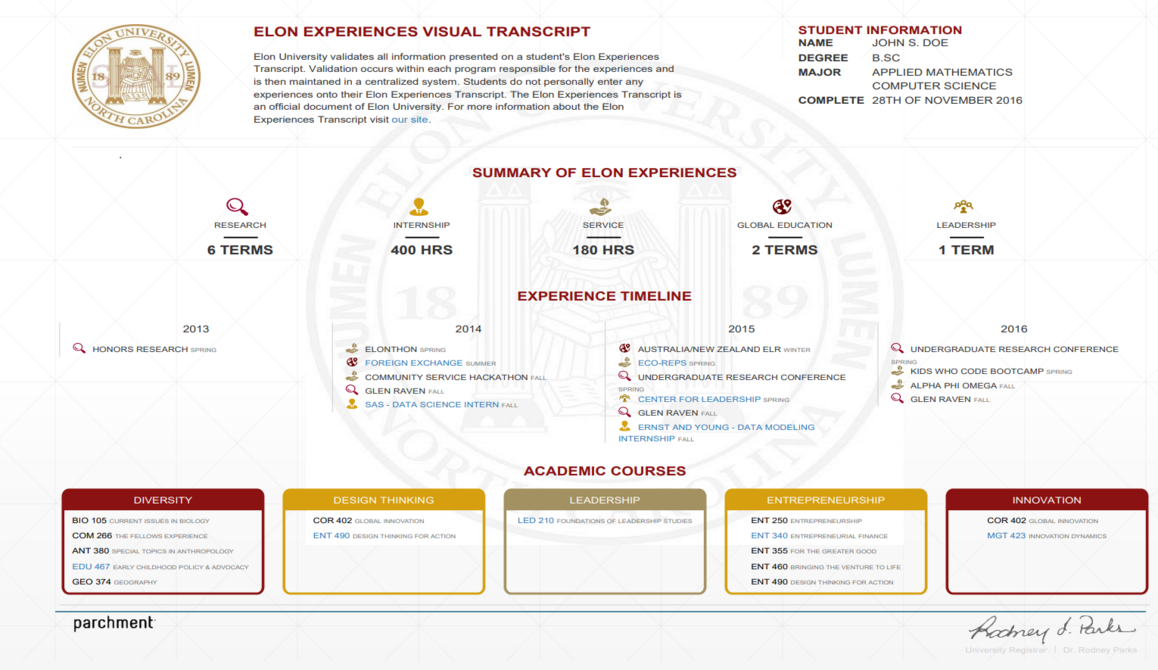
Image Credit: Elon University's Visual Experiential Transcript
As Student Affairs professionals, we know the importance of demonstrating and assessing student learning. Many institutions use tools such as co-curricular transcripts to help students document their experiences. The current platform that we use at my institution, Campus Labs/ Engage, allows students to build a co-curricular transcript. We recently joined a cohort with AACRAO and NASPA to develop a comprehensive learner record (CLR).
Why Switch?
Unlike the co-curricular transcript, the CLR can be tied to our institutional and divisional learning outcomes. For example, an outcome of “diversity and inclusion” can be tied to a student attending multiple events and completing a reflection or portfolio to demonstrate their learning. Targeted populations, such as student leaders, have a customized CLR that provides structure for their co-curricular requirements. When we think about student learning from a Student Affairs standpoint, we consider a diverse array of examples such as in Student Government, New Student Orientation leaders, volunteerism/service and through student organizations. The beauty of the CLR is that we can be more transparent in modeling skills and knowledge that students can acquire during their experiences. Teaching and leading the expectation for students to participate in the CLR as new students also helps them build the habit early of being intentional in their campus engagement.
Examples of CLRs
There are several existing CLR models to learn more about the use and value of these records in higher education. Elon University has a long-standing history of documenting student co-curricular learning through established and required student experiences such as leadership and undergraduate research. Elon’s Visual Experiential Transcript notes student engagement by length of time such as hours or academic terms and provides the timeline of a student’s academic matriculation.
The University of Central Oklahoma emphasizes student growth in their Student Transformative Learning Record. Students can earn credit (from exposure to integration to the transformation) based on the amount of evidence of learning they provide. Similar to Elon, the STLR model is based on the Central Six Tenets such as Service-learning and Civic Engagement or Health and Wellness. Students can view a calendar that tags all events back to a Central Six Tenet as they map out desired activities that they plan to attend.
Where to Begin/Considerations
As we begin this work on my campus, we created a committee that includes faculty, staff and students to think through what areas we would like to highlight on our CLR. Our current practice is to train every new incoming class on the Engage platform during New Student Orientation. This will allow us to highlight the value of the CLR to our new students so that they can be excited about taking control of their co-curricular learning.
I like this tool as a method for students to be included from day one in their own learning. Not only do students see their learning tied back to important concepts like service, leadership or diversity, but the CLR helps them to continuously document and articulate their learning to themselves, potential employers or graduate/professional schools. This tool serves as the catalyst for more campus dialog related to the learning that takes place both inside and outside of the classroom. Communication and intentional design really will be the key in effectively developing this project. How can we best implement this tool and ensure its use in academic and Student Affairs departments? How can the CLR add value to our assessment toolkit?
For campuses who are considering moving to a CLR, it is important to note that this can be quite the undertaking. A strong campus collaboration is necessary for considerations such as technology integration, validation of the record and the institutional framework to use related to student learning. Luckily, the IMS Global Learning Consortium has a great inventory of resources including more models of institutional CLRs and two occasional papers from NILOA.
If you’re excited to implement a CLR on your campus, or at least think through a more structured co-curricular learning structure, you don’t have to reinvent the wheel. The CLR serves as a promising opportunity to help students see their holistic learning experiences aligned with institutional outcomes.
Cheraton Love, PhD, Winston-Salem State University
